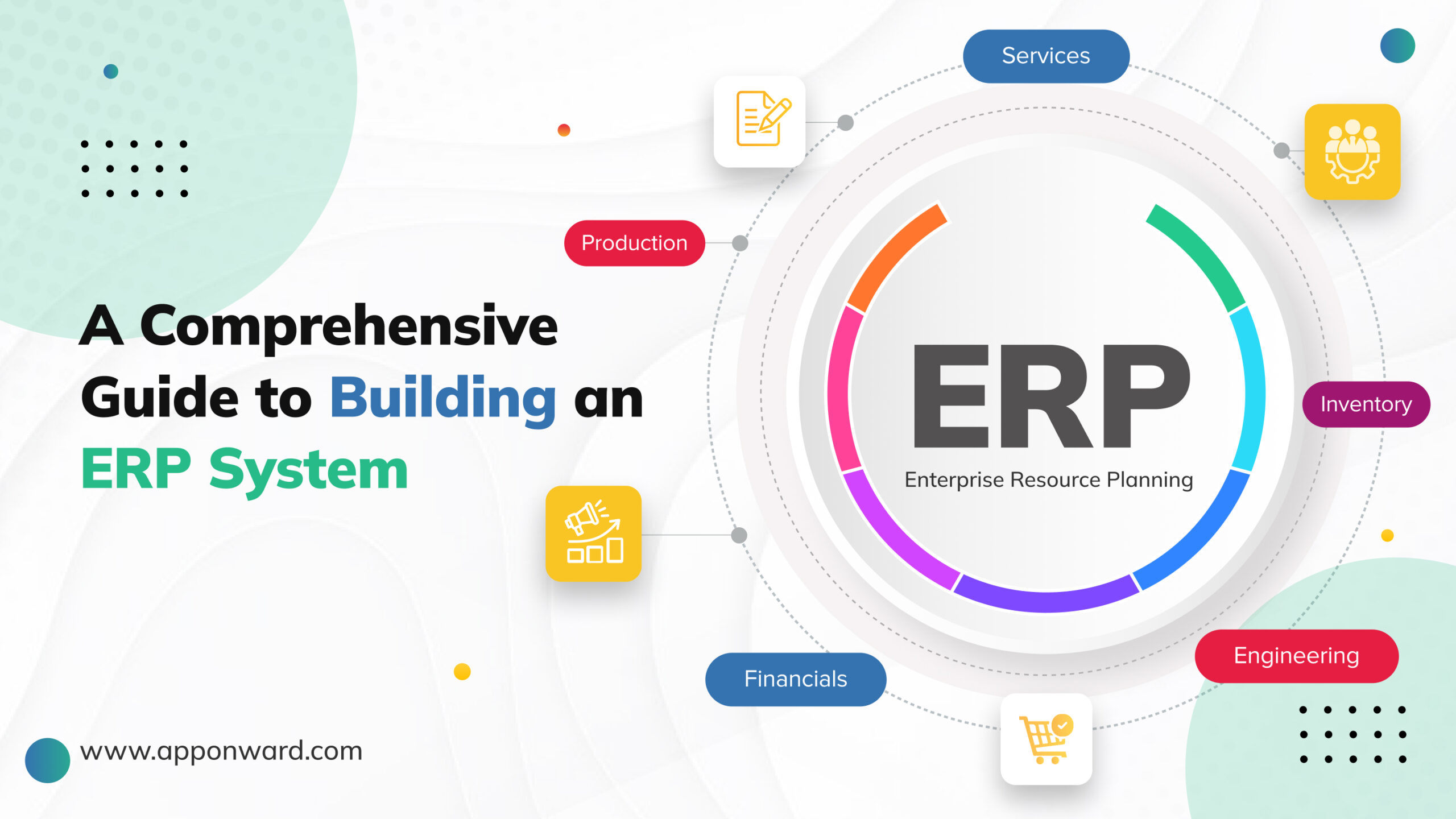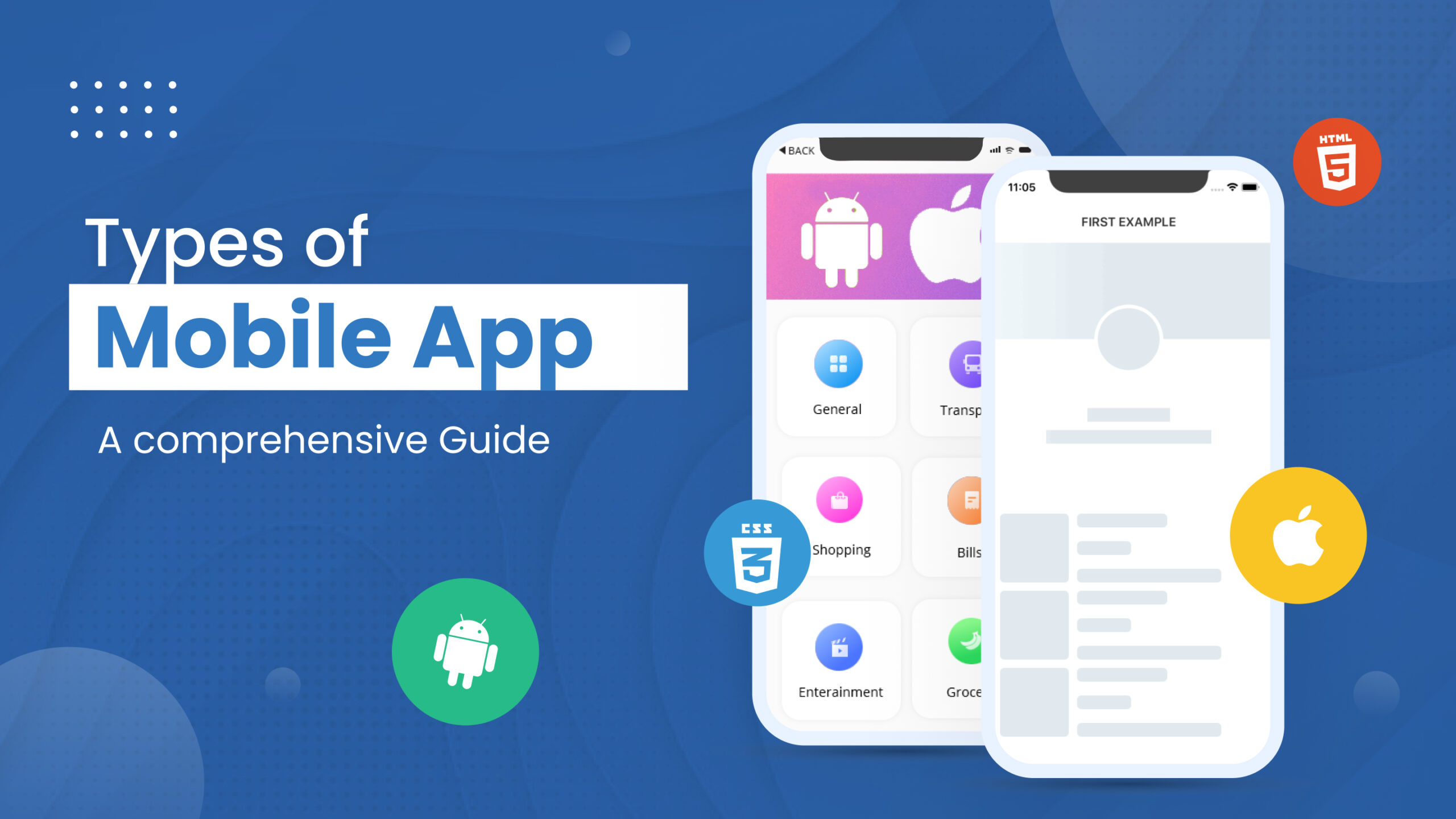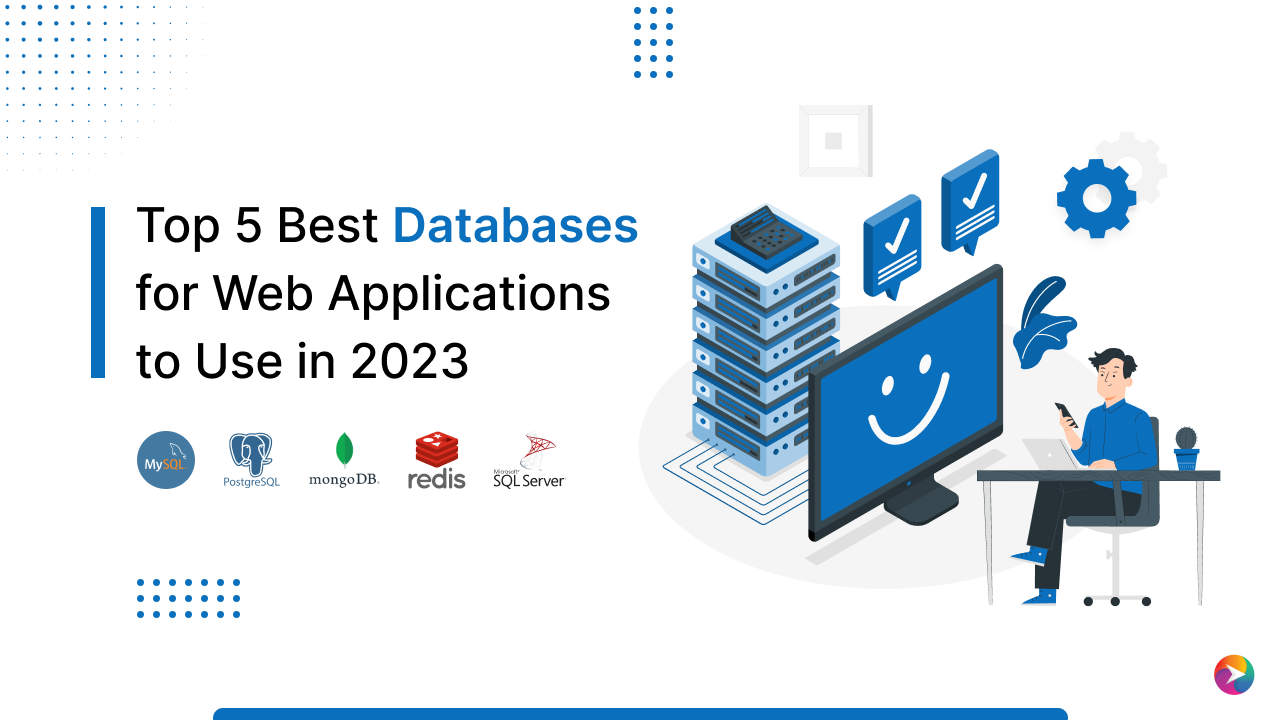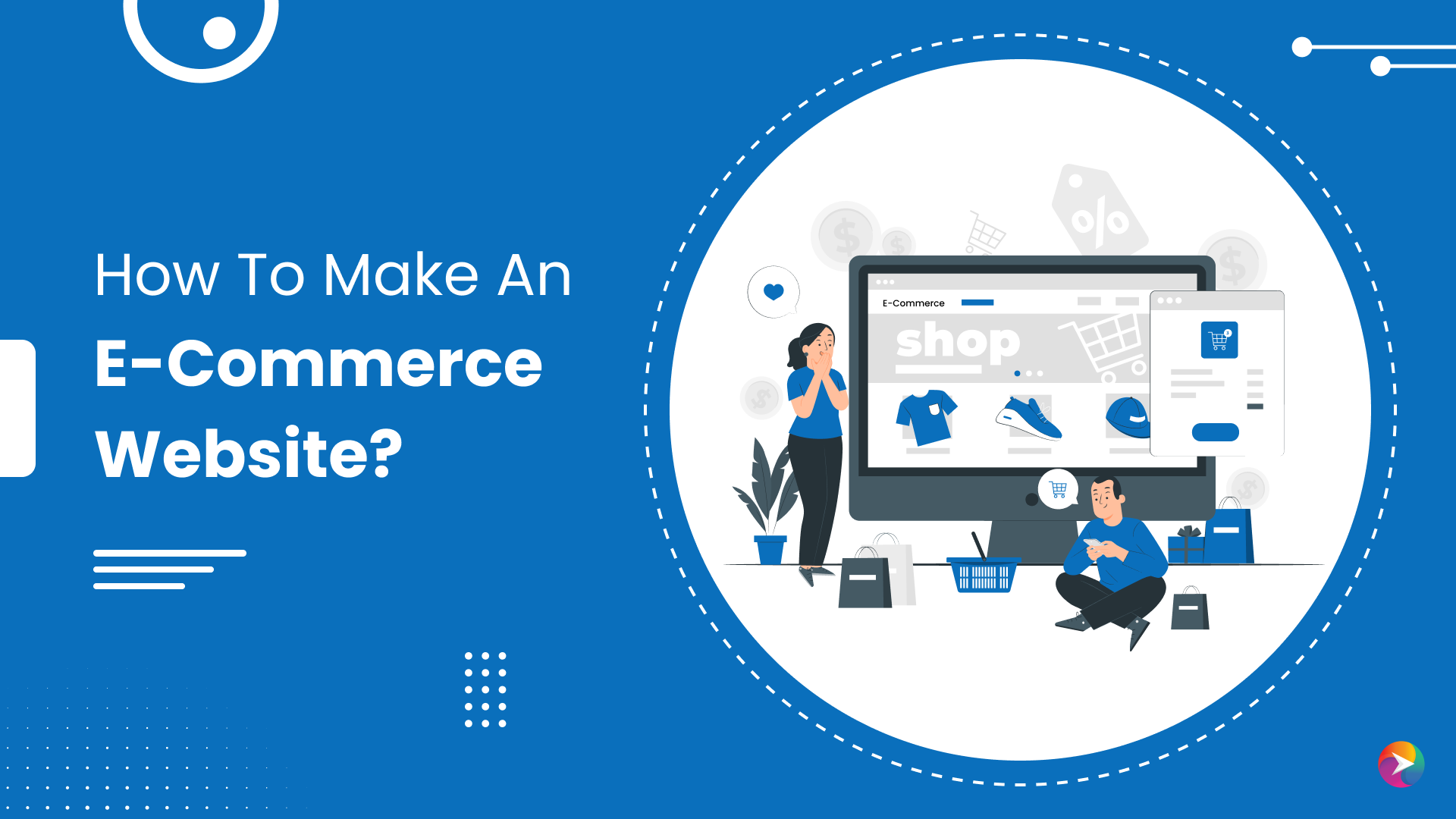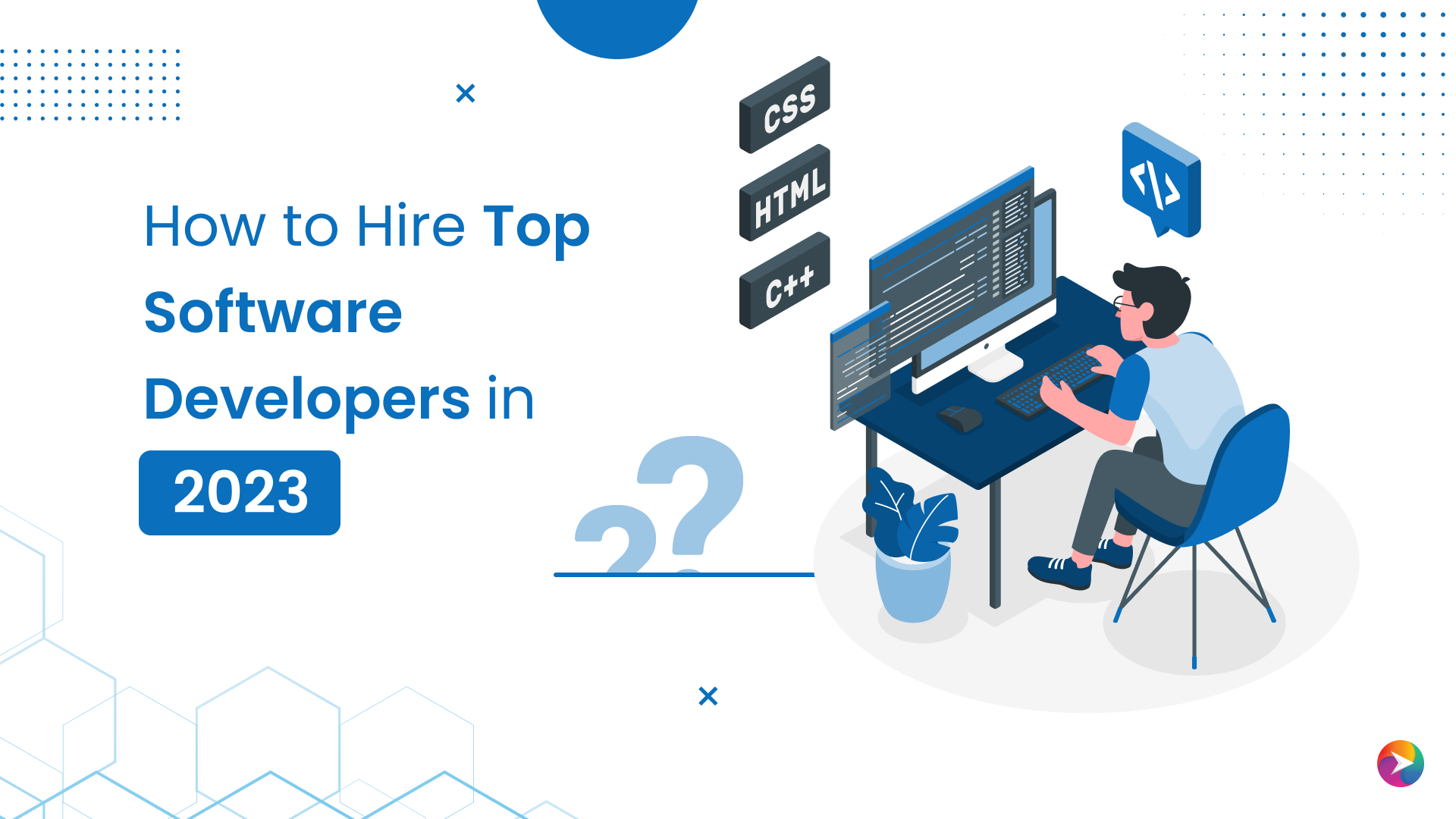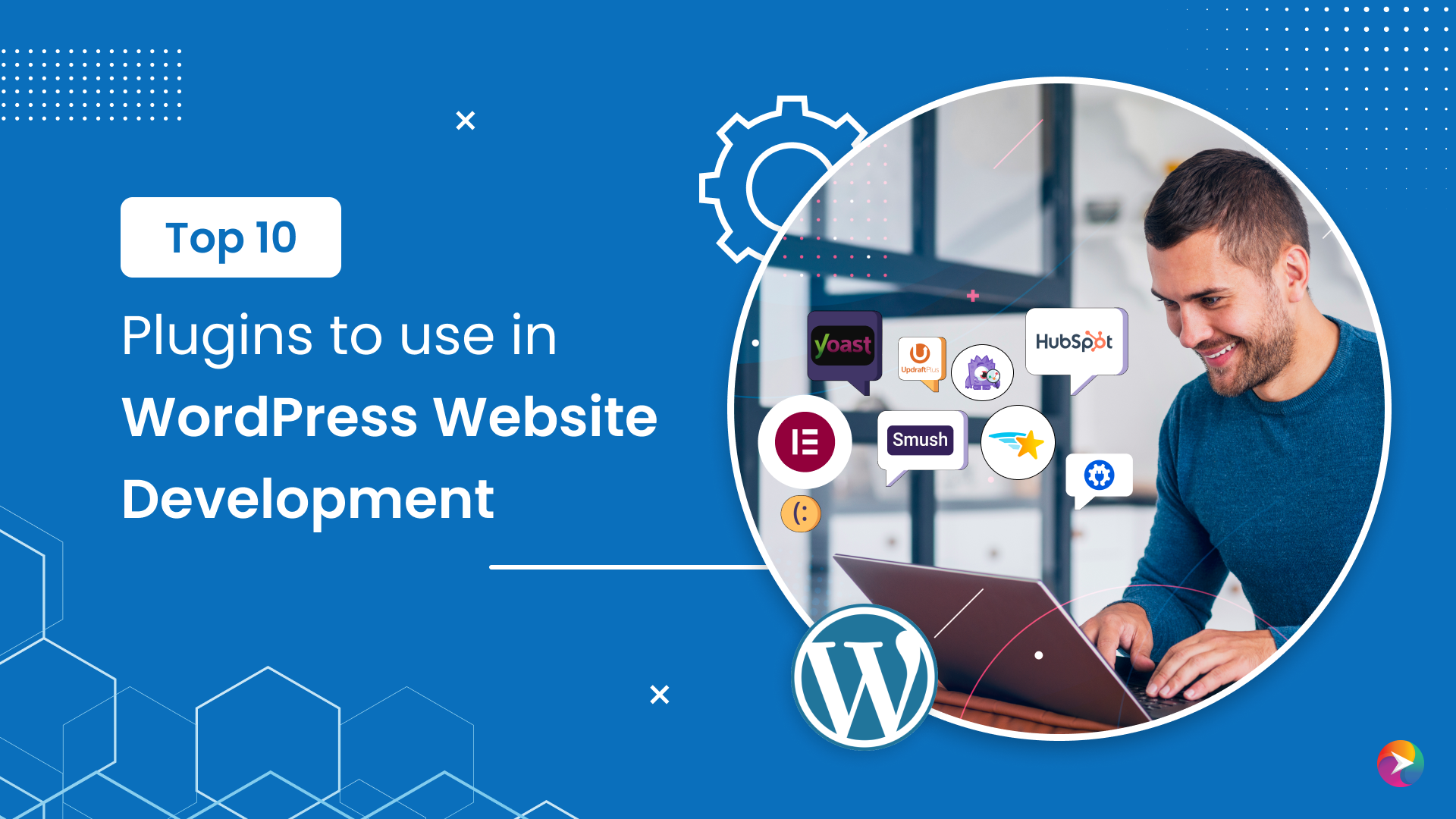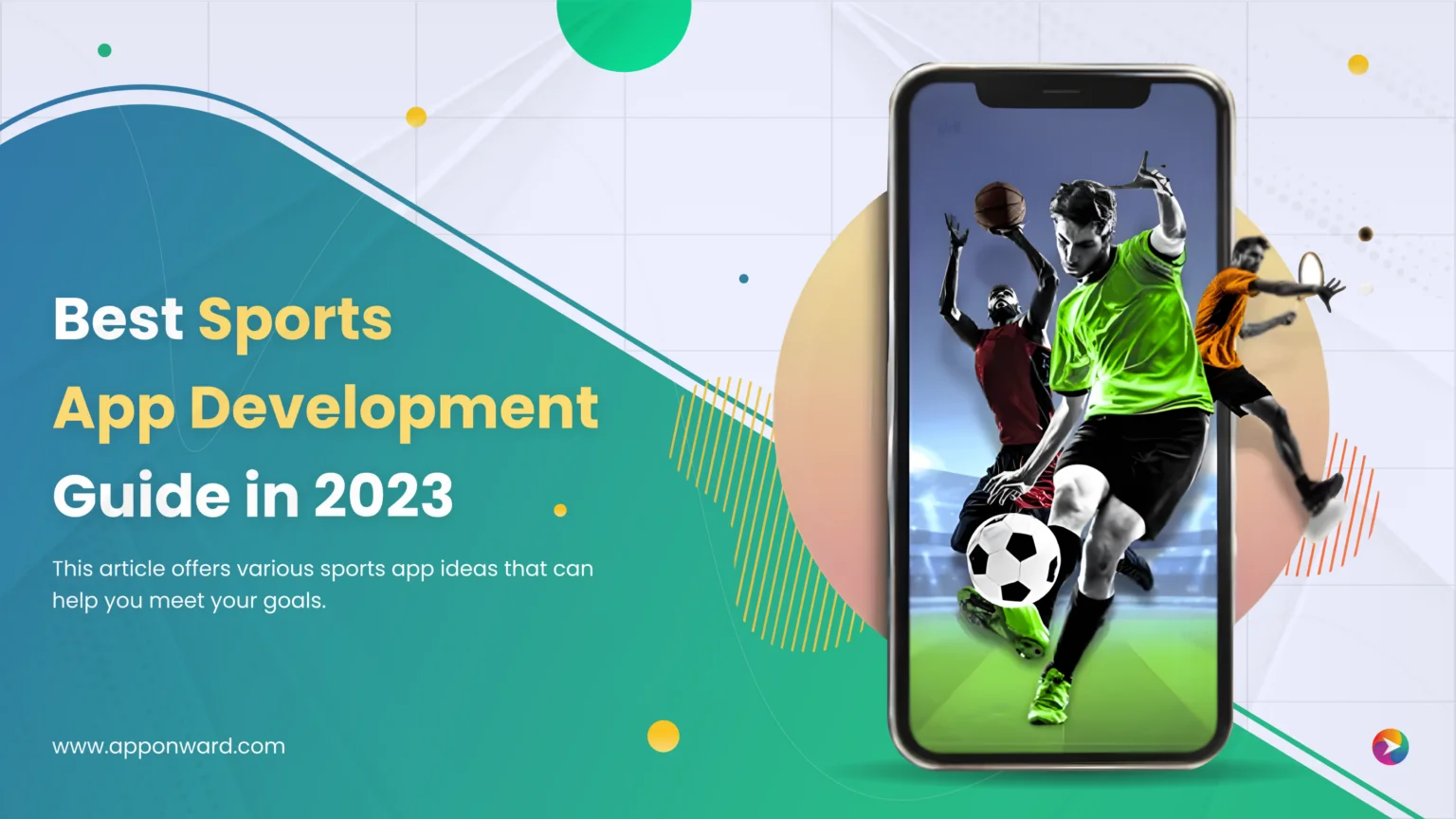 08/12/2023
08/12/2023 
Anand Kumar Mishra
5 Mins to Read
Table of content
In today’s dynamic business landscape, efficiency and agility are not just buzzwords; they are the cornerstones of success. However, achieving this elusive harmony can be challenging when data is kept across departments and processes are scattered like puzzle pieces. This is where the Enterprise Resource Planning (ERP) system emerges as a knight in shining armor.
An ERP system acts as your digital sword, uniting various functions into a single, centralized platform. It serves as the maestro orchestrating your inventory, finances, customer interactions, and more, harmonizing your operations into a symphony of success.
While the benefits of an ERP system are undeniable, building one isn’t a walk in the park. It’s a strategic endeavor that demands careful planning and execution. This comprehensive guide will equip you with the knowledge and tools to navigate the ERP development process.
Process of ERP Software Development
Building an ERP system isn’t a uniform task; it’s a layered approach that requires careful consideration of each stage. Following are the key phases:
1. Defining Your Needs:
The journey begins with introspection. What are your pain points? Which processes are bogged down? What data needs to flow seamlessly? Charting your business goals and outlining specific functionalities ensures that your ERP system aligns with your unique needs, not the other way around.
2. The Technology Stack:
Think of your ERP system as a building. The tech stack is its foundation. Will you use open-source frameworks, pre-built modules, or custom coding? Each approach has its advantages and trade-offs. Consider factors like scalability, flexibility, and integration capabilities when making your choice.
3. User Interface (UI) and User Experience (UX):
Your ERP system might be powerful, but if it’s clunky and confusing, it’s a recipe for disaster. Invest in intuitive UI/UX design that prioritizes user-friendliness. Remember, your employees are the ones wielding this blade, so empower them with a smooth, efficient interface.
4. Development and Integration:
Whether you’re building from scratch or customizing a pre-built solution, the development process demands meticulous attention to detail. Seamless integration with existing systems is crucial to avoid data discrepancies and ensure a unified flow of information.
5. Testing and Deployment:
Before unleashing your ERP system onto the real world, rigorous testing is crucial. Identify and eliminate bugs, refine workflows, and gather user feedback. A successful deployment hinges on a flawless launch, so don’t skip this vital stage.
Cost Considerations: Building vs. Buying
The age-old dilemma: build or buy? Both paths have their advantages, and the choice ultimately depends on your budget, technical expertise, and desired level of control.
Custom ERP Software Development:
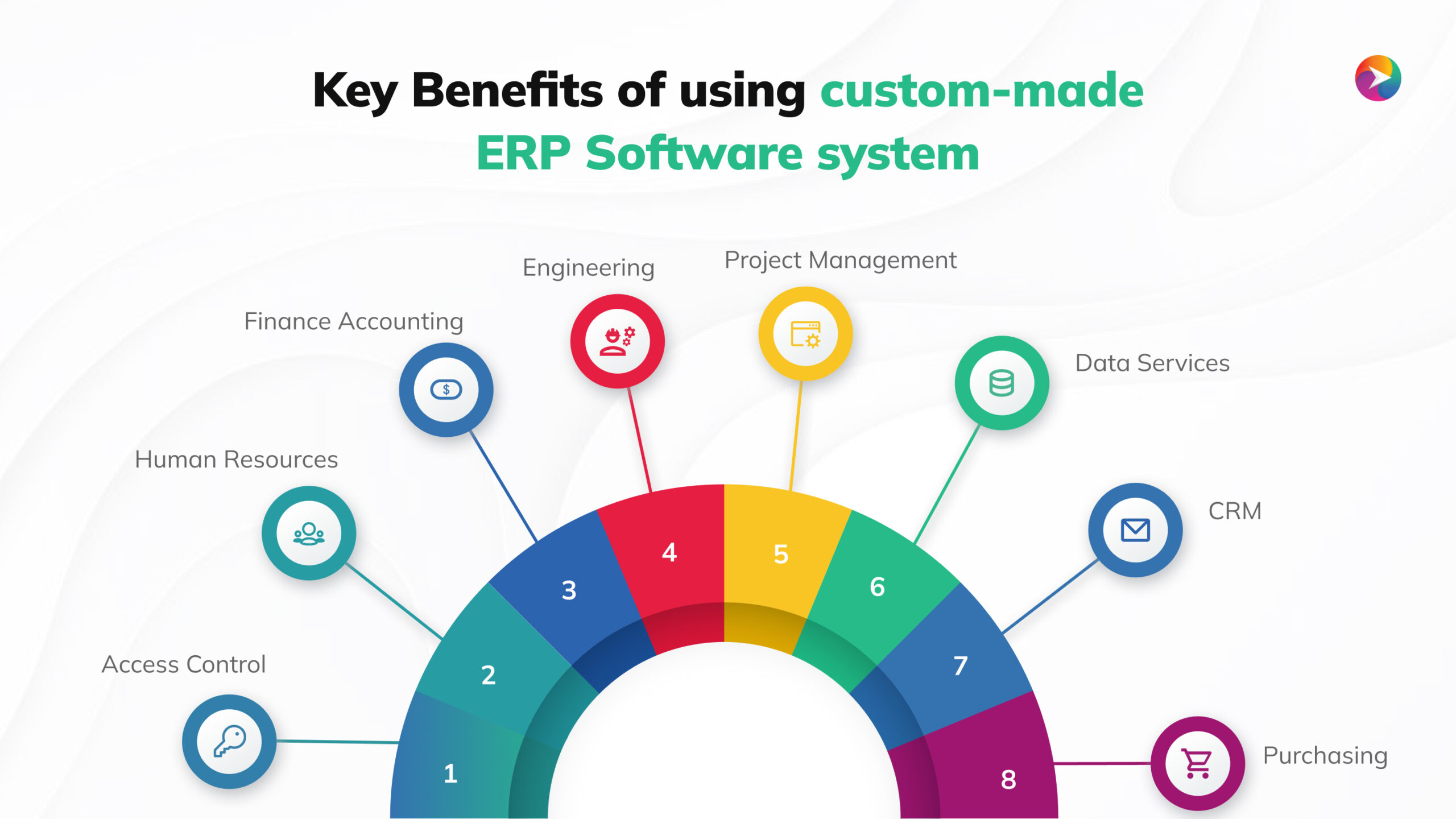
- Pros: Tailored to your specific needs, highly scalable, increased control over data and security.
- Cons: Higher upfront cost, longer development time, dependence on skilled in-house developers.
Pre-built ERP Software:
- Pros: Faster deployment, lower initial cost, access to pre-built functionalities.
- Cons: Limited customization, potential compatibility issues, ongoing licensing fees.
Building Your Dream Team:
Whether you choose to build in-house or partner with an ERP software development company, assembling the right team is paramount. Look for developers with:
- ERP development experience: They understand the intricacies of building these complex systems.
- Strong technical skills: Expertise in your chosen tech stack is essential.
- Problem-solving mindset: Inevitably, challenges will arise. You need a team that thrives on solutions.
- Communication prowess: Clear, concise communication between stakeholders is key to a successful project.
Conclusion
Building an ERP system is a strategic investment, not just a software project. It’s about transforming your business into a well-oiled machine, eliminating inefficiencies, and unlocking hidden potential.
Remember, this guide is your roadmap, not a rigid script. Adapt it to your specific needs, embrace the challenges, and most importantly, believe in the power of a unified future.
Looking for a reliable and efficient Mobile/Web app developer? Contact us today!
 30/11/2023
30/11/2023 
Anand Kumar Mishra
7 Mins to Read
Table of content
The world of mobile apps is vast and ever-evolving, offering a plethora of solutions for businesses and individuals alike. With smartphones and tablets becoming ubiquitous tools, the demand for innovative and engaging mobile applications has skyrocketed. Understanding the different types of mobile apps is crucial for making informed decisions about app development and choosing the right approach for your specific needs.
Following are the type of Mobile apps and their pros and cons to help you make an informed decision:
Types of Mobile Apps
Mobile apps can be broadly categorized into three main types: native apps, web apps, and hybrid apps. Each type has its own unique characteristics, advantages, and limitations, making it essential to carefully consider these factors when selecting the most suitable option for your app project.
Native Apps
Native apps are designed and developed specifically for a particular mobile operating system, such as iOS or Android. They are built using the native programming language of the respective platform, allowing them to harness the full potential of the device’s hardware and software capabilities.
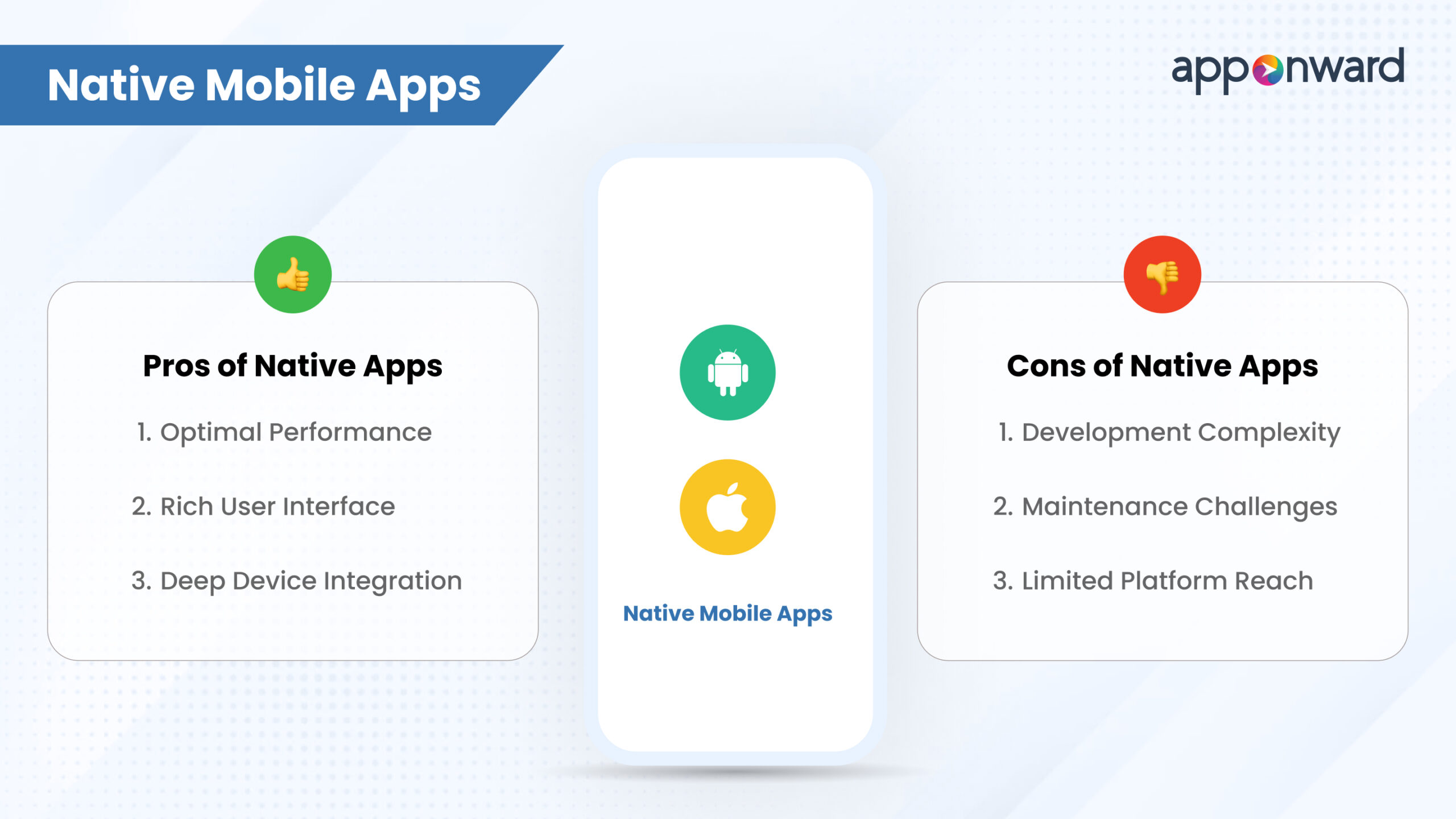
Pros of Native Apps:
- Optimal Performance: Native apps offer exceptional speed, responsiveness, and seamless integration with the device’s features, providing a superior user experience.
- Rich User Interface: Native apps can leverage the device’s native UI elements to create a visually appealing and intuitive interface that aligns with user expectations.
- Deep Device Integration: Native apps can access the device’s hardware capabilities, such as camera, GPS, and sensors, enabling rich and personalized features.
Cons of Native Apps:
- Development Complexity: Native app development requires expertise in specific programming languages and platforms, increasing the overall development cost and time.
- Maintenance Challenges: Updates and maintenance for native apps need to be tailored to each platform, adding to the ongoing cost and complexity.
- Limited Platform Reach: Native apps are confined to a single platform, restricting their reach to users of that specific operating system.
Web Apps
Web apps are essentially websites that are optimized for viewing and interacting with on mobile devices. They are developed using web technologies like HTML, CSS, and JavaScript, and are typically accessed through a mobile web browser.
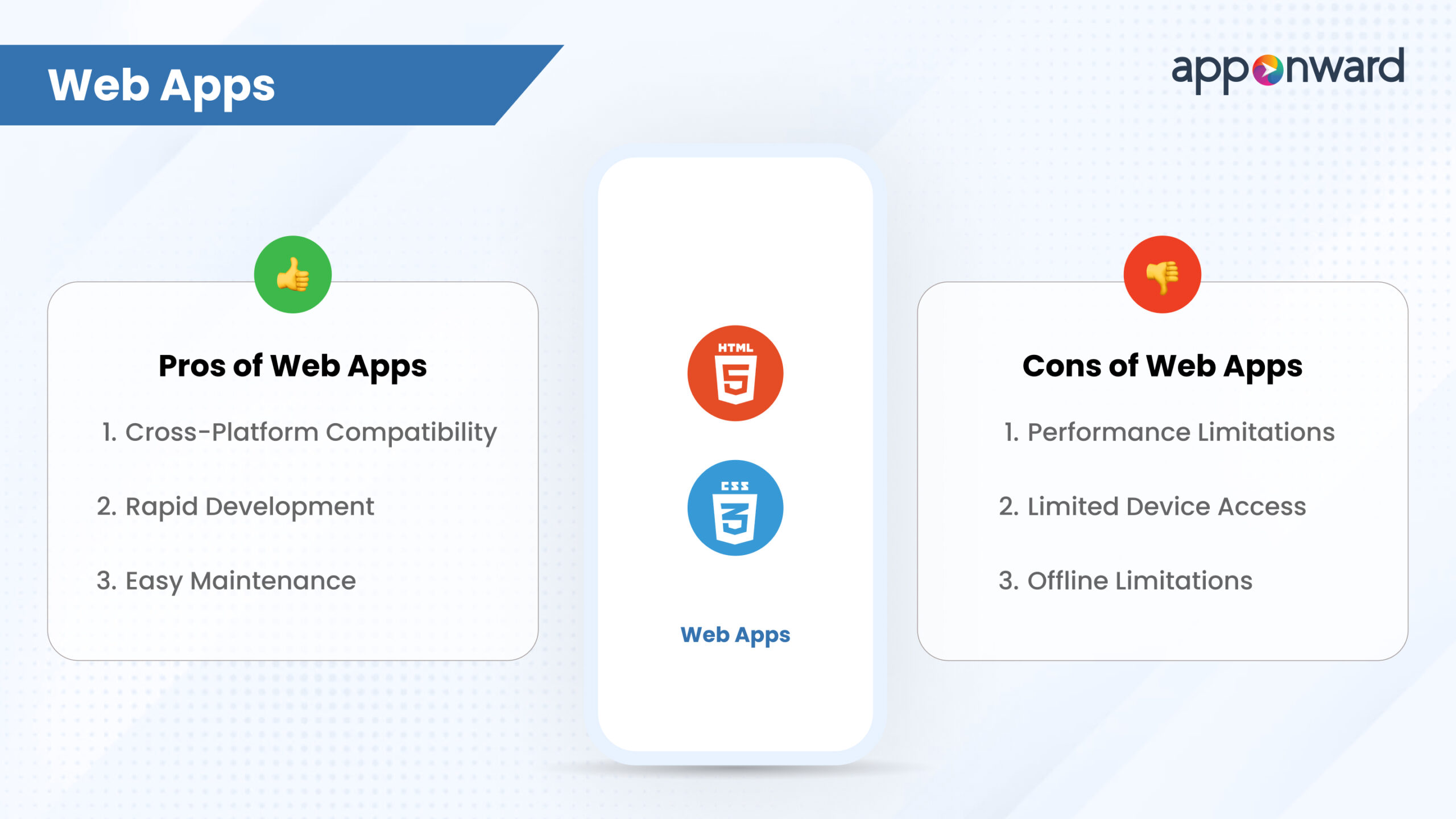
Pros of Web Apps:
- Cross-Platform Compatibility: Web apps can be accessed and used on any device with a web browser, regardless of the operating system.
- Rapid Development: Web apps can be developed relatively quickly and efficiently using standard web development tools and frameworks.
- Easy Maintenance: Updates and maintenance for web apps are centralized, making them more cost-effective and efficient.
Cons of Web Apps:
- Performance Limitations: Web apps may not offer the same level of performance and responsiveness as native apps, potentially affecting user experience.
- Limited Device Access: Web apps may have restricted access to certain device features compared to native apps.
- Offline Limitations: Web apps typically require an internet connection to function, limiting their usability in offline scenarios.
Hybrid Apps
Hybrid apps combine elements of both native and web app technologies. They are developed using a web development framework like React Native or Ionic, and the resulting app is packaged within a native app container.
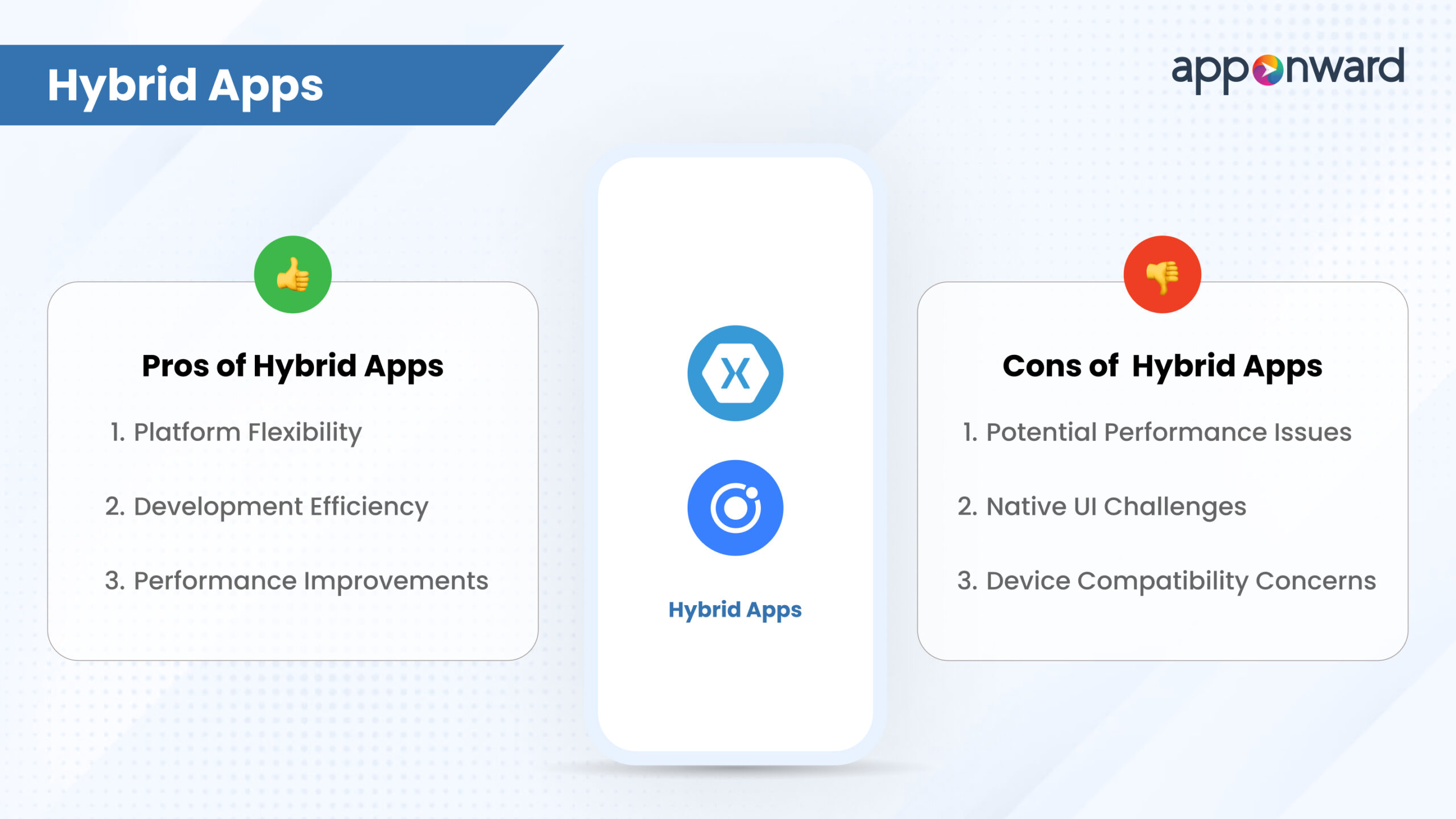
Pros of Hybrid Apps:
- Platform Flexibility: Hybrid apps can be deployed to multiple platforms, offering a wider reach compared to native apps.
- Development Efficiency: Hybrid apps can leverage web development skills, potentially reducing development costs and time.
- Performance Improvements: Hybrid apps can achieve performance closer to native apps, especially with advancements in web technologies.
Cons of Hybrid Apps:
- Potential Performance Issues: Hybrid apps may still face performance limitations compared to native apps, particularly in complex interactions.
- Native UI Challenges: Achieving a native-like user interface across platforms can be challenging with hybrid apps.
- Device Compatibility Concerns: Some hybrid app frameworks may have compatibility issues with specific device types or versions.
How To Choose The Right Type Of Mobile App
The decision of which type of mobile app to develop depends on various factors, including the app’s purpose, target audience, budget, and desired functionality.
- For apps that demand top-notch performance, a rich user experience, and seamless integration with device features, native apps are the preferred choice.
- If cross-platform compatibility, rapid development, and centralized maintenance are priorities, web apps offer a compelling solution.
- Hybrid apps provide a balance between platform reach, development efficiency, and performance improvements, making them a suitable option for certain scenarios.
Also Read: Native vs. Hybrid Apps: Choosing the Best in 2023
Conclusion
The ever-evolving landscape of mobile apps presents a wealth of opportunities for businesses and individuals to engage with their target audience. By understanding the distinct characteristics and advantages of native, web, and hybrid apps, informed decisions can be made to choose the right approach for specific app development needs.
If you are looking for a top mobile app development company, contact Apponward Technologies now!
 28/11/2023
28/11/2023 
Anand Kumar Mishra
5 Mins to Read
Table of content
In the ever-evolving world of web applications, the choice of database plays a crucial role in determining the performance, scalability, and overall success of an application. A database serves as the backbone of a web application, storing and managing the vast amounts of data that power its functionality. With numerous database options available, selecting the right one can be a daunting task for developers.
In this blog, we delve into the top 5 best databases for web applications to use in 2023, providing insights into their strengths, features, and suitability for various web application scenarios.
What is a Database?
A database is an organized collection of data stored electronically, typically on a computer system. It serves as a repository for information, allowing for efficient access, retrieval, and manipulation of data. Databases are:
- Essential components of web applications.
- Enabling the storage and management of user data.
- Application data.
- Other crucial information.
Database Management in Web Applications
Database management plays a pivotal role in web application development. It encompasses the process of organizing, storing, retrieving, and manipulating data within a database. Effective database management ensures that data is consistent, secure, and readily accessible to the web application, thereby enabling seamless user experiences and application functionality.
Types of Databases
Databases can be categorized into two primary types:
Relational Databases
Relational databases adhere to a structured format, organizing data into tables with rows and columns. Each row represents a record, and each column represents a specific attribute of that record. Relational databases are ideal for storing and managing highly structured data with well-defined relationships between data entities.
Non-relational Databases
Non-relational databases, also known as NoSQL databases, offer a more flexible approach to data storage. They are designed to handle unstructured or semi-structured data, such as documents, JSON objects, and graphs. NoSQL databases are particularly well-suited for applications that require high scalability and flexibility, such as social media platforms and e-commerce websites.
Top 5 Best Databases for Web Applications
MySQL
MySQL is a widely used open-source relational database management system (RDBMS) known for its ease of use, scalability, and reliability. It is a popular choice for web applications of all sizes, ranging from small websites to large enterprise systems.
MySQL’s strengths lie in its simplicity, performance, and extensive community support.
PostgreSQL
PostgreSQL is another open-source RDBMS that offers powerful features and advanced data types, making it suitable for complex web applications with demanding data requirements.
PostgreSQL’s strengths include its robustness, scalability, and compliance with ACID (Atomicity, Consistency, Isolation, Durability) principles.
MongoDB
MongoDB is a NoSQL document-oriented database that stores data in JSON-like documents, providing flexibility and scalability for handling unstructured data. It is a popular choice for web applications that require rapid development and high performance with large volumes of unstructured data.
MongoDB’s strengths include its ease of use, scalability, and ability to handle unstructured data efficiently.
Microsoft SQL Server
Microsoft SQL Server is a commercial RDBMS known for its enterprise-level features, security, and integration with Microsoft products. It is a popular choice for large-scale web applications that require high performance, reliability, and tight integration with Microsoft technologies.
Microsoft SQL Server’s strengths include its scalability, security, and performance optimization for enterprise applications.
Redis
Redis is an in-memory data store that offers high performance for caching and real-time applications. It is often used in conjunction with other databases to improve performance and handle real-time data processing.
Redis’s strengths include its high speed, in-memory data storage, and ability to handle real-time data processing efficiently.
Conclusion
The choice of database for web applications depends on various factors, including the type of data, application requirements, scalability needs, and budget constraints. Each database option offers unique strengths and suitability for specific web application scenarios.
By carefully evaluating the requirements of the web application, developers can select the database that best aligns with the needs of the project, ensuring optimal performance, scalability, and user experience.
Visit Apponward for the Best Web Application Development Services!
 17/11/2023
17/11/2023 
Anand Kumar Mishra
4 Mins to Read
Table of content
Choosing the Right E-commerce Platform
The first step in your e-commerce journey is selecting the right platform to build your website. Popular options include Shopify, WooCommerce, and BigCommerce. Each platform offers unique features and functionalities, so it’s essential to evaluate your specific needs and budget before making a decision.
Hire an eCommerce Website Developer
While e-commerce website builders offer convenience, hiring a web developer can provide several advantages. Web developers have specialized skills that can elevate your website’s functionality, design, and user experience. They can create a unique and tailored website, seamlessly integrate it with e-commerce platforms, and enhance its security, reliability, and search engine visibility. By hiring a web developer, you can establish a strong foundation for your e-commerce success.
Domain Name and Hosting
Once you’ve chosen your platform, it’s time to secure your domain name and hosting. Your domain name is your website’s address on the internet, while hosting provides the server space for your website’s files. Choose a domain name that is easy to remember and relevant to your brand. For hosting, consider reputable providers that offer reliable uptime and support.
Themes and Customization
The aesthetic appeal of your e-commerce website plays a significant role in attracting and retaining customers. Most e-commerce platforms offer a variety of themes, which are pre-designed layouts that you can customize to match your brand and style. Don’t hesitate to personalize the theme to create a unique and engaging shopping experience.
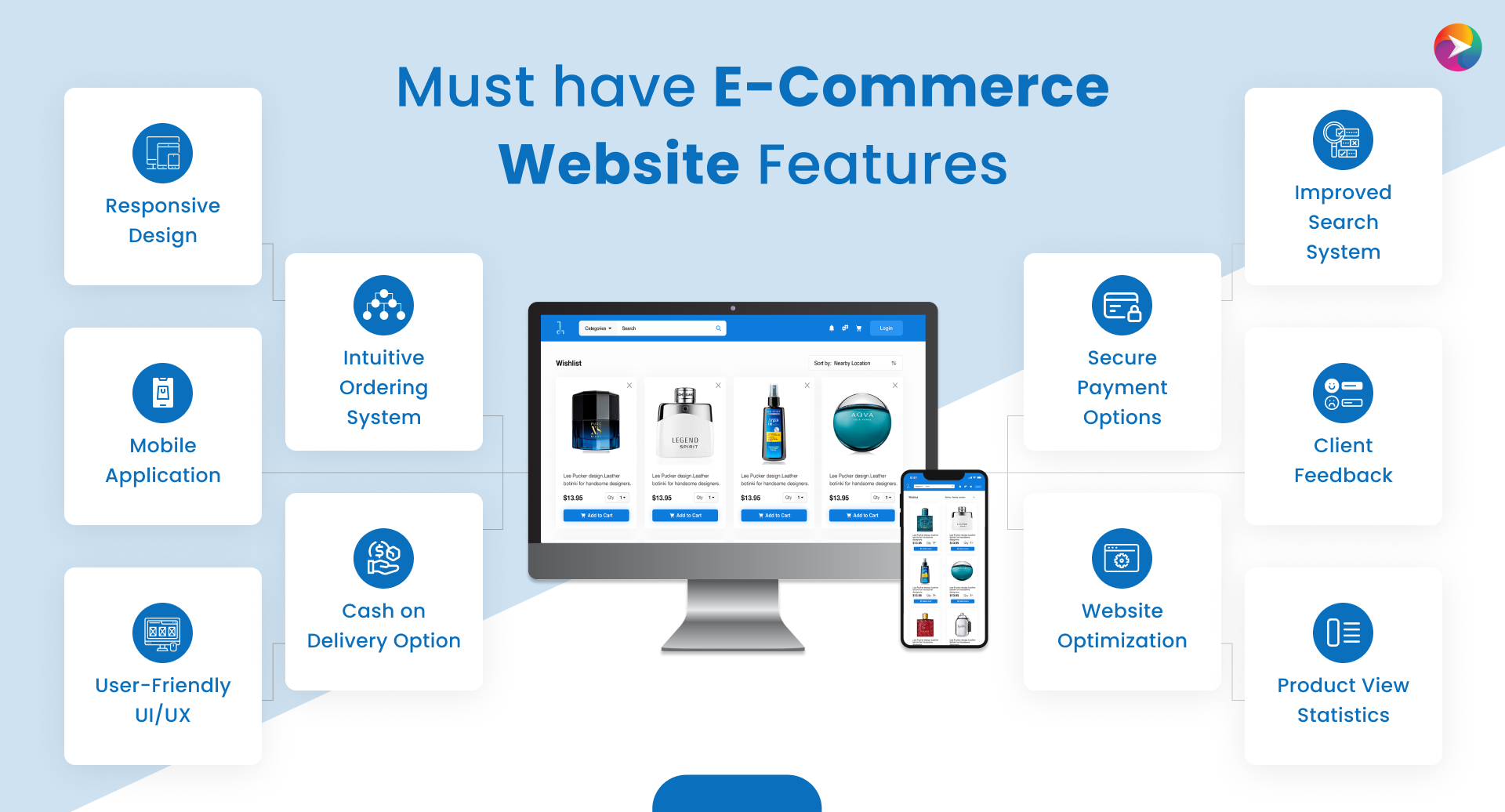
Product Listings and Descriptions
High-quality product listings are essential for converting visitors into customers. Ensure that your product images are clear and well-lit, and provide detailed descriptions that highlight the product’s features and benefits. Use relevant keywords throughout your product descriptions to improve search engine visibility.
Payment Gateways and Shipping Options
Secure payment gateways are crucial for processing customer transactions. Integrate reputable payment processors like PayPal or Stripe to ensure secure and convenient online payments. Additionally, offer multiple shipping options to cater to different customer preferences and locations.
Marketing and Promotion
Once your e-commerce website is live, it’s time to spread the word. Utilize various marketing channels, such as social media, email campaigns, and search engine optimization (SEO), to attract potential customers. Engage with your audience, offer promotions, and provide excellent customer service to foster brand loyalty.
Enhancing Customer Experience
In addition to a traditional e-commerce website, consider developing a mobile app for your online store. Mobile apps provide a convenient and personalized shopping experience, allowing customers to browse products, make purchases, and manage their orders on the go.
Grofkit: A Dairy-centric E-commerce Solution
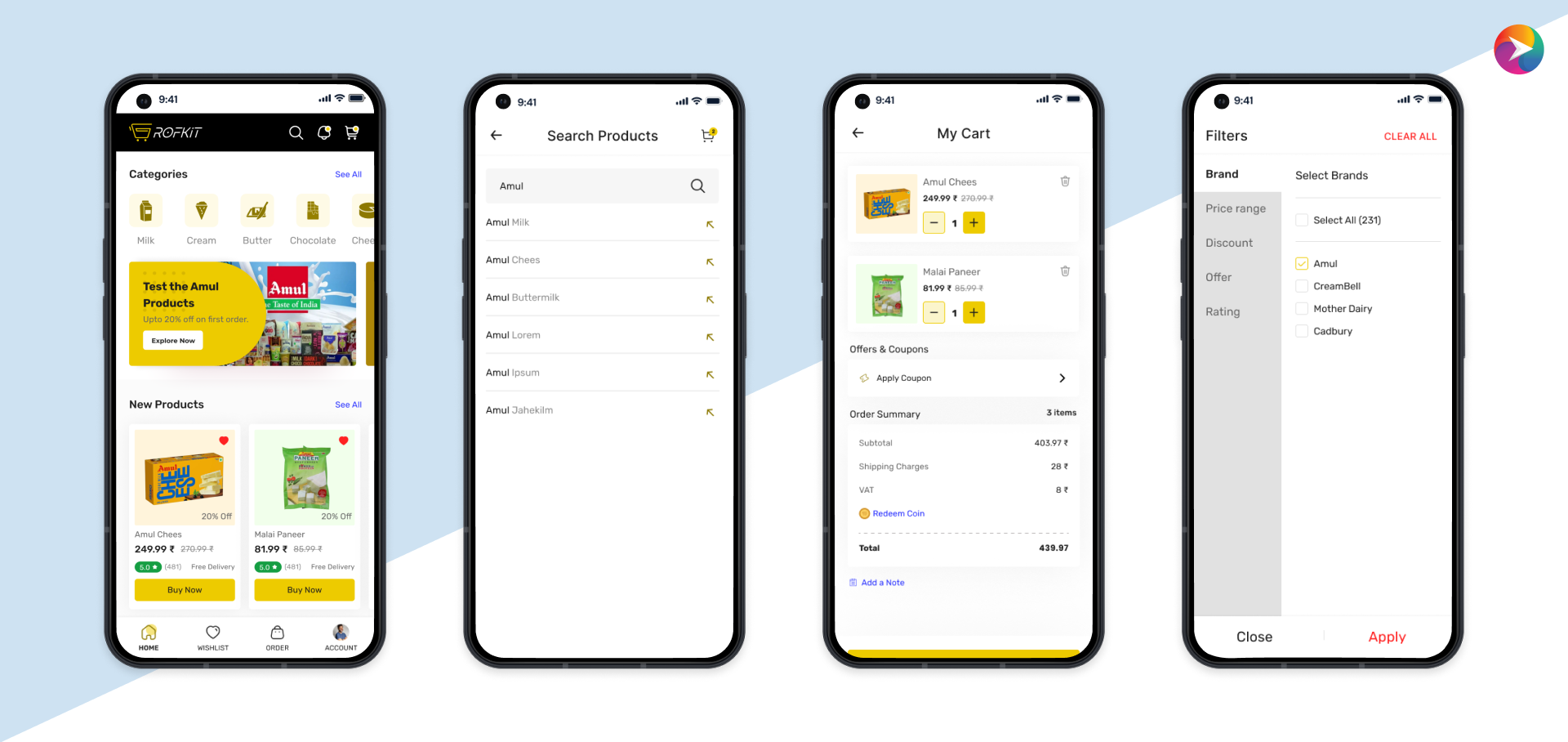
Apponward’s Grofkit is an innovative e-commerce mobile solution tailored to the dairy industry. As a mobile app development company, we’ve collaborated with Apponward to create Grofkit, providing a one-stop shop for all dairy-related needs. Grofkit enables users to easily purchase a wide range of dairy products within a defined range, streamlining their shopping experience.
Conclusion
Creating a successful e-commerce website requires careful planning, execution, and ongoing maintenance. By following these steps and utilizing the resources available, you can establish a thriving online store that reaches a wider audience and drives sales. Remember, e-commerce is a dynamic landscape, so stay updated on the latest trends and technologies to keep your store competitive and engaging.
Looking for a reliable eCommerce app developer? Contact us today to turn your ideas into reality!
 03/11/2023
03/11/2023 
Anand Kumar Mishra
5 Mins to Read
Table of content
In today’s technology-driven world, software developers are in high demand. Whether you’re a startup looking to build a groundbreaking app or an established company seeking to expand your development team, finding and hiring top software developers is essential for success.
In this article, we will explore various strategies to help you hire top software developers in 2023.
Define Your Requirements
Before you start the hiring process, it’s crucial to clearly define your project requirements and the specific skills you’re looking for in a software developer. Knowing whether you need a web developer, a mobile app developer, or a full-stack developer will help you target your search more effectively. Take the time to identify the technologies, languages, and tools that are essential for your project’s success.
Explore Different Hiring Options
There are several ways to hire software developers in 2023, each with its own advantages and disadvantages:
A. In-House Hiring: This involves hiring a software developer as a full-time employee. It offers more control but can be expensive. Consider the long-term commitment and budget needed for this option.
B. Freelancers: Freelancers provide flexibility but may lack the commitment of full-time employees. They are a great choice for short-term or project-based work.
C. Outsourcing: Outsourcing to a software development company can provide cost-effective solutions and access to a wider talent pool. It’s an option that can save you time and resources.
Where to Find Software Developers
To hire top software developers, explore the following avenues:
A. Online Job Platforms: Websites like LinkedIn, Indeed, and Glassdoor are excellent places to post job listings and search for potential candidates. Use these platforms to connect with a vast pool of talent.
B. Tech Communities: Engage with tech communities and forums, attend meetups, and network with developers through platforms like GitHub. This approach allows you to tap into the expertise of the tech community.
C. Recruitment Agencies: Consider partnering with recruitment agencies specializing in tech talent. These agencies have the experience and network to identify the right candidates for your needs.
D. Outsource Companies: If you choose to outsource your project, collaborate with established custom software development companies that have a track record of success. Make sure to review their past projects and client testimonials.
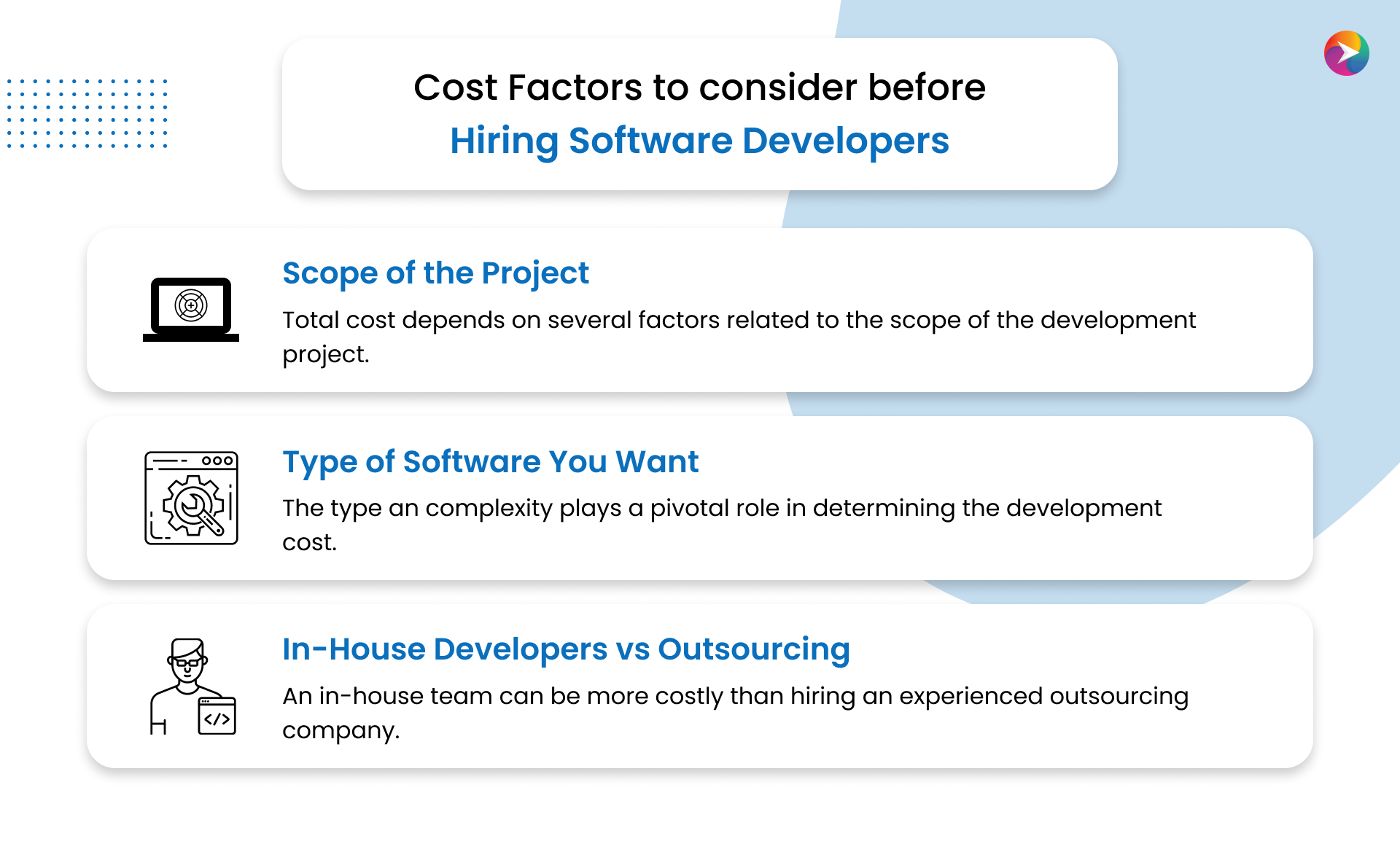
Assess Technical Skills
Technical assessments, coding challenges, and portfolio reviews are vital steps in the hiring process. Check a candidate’s proficiency in the technologies and tools relevant to your project. Be prepared to provide practical coding challenges to assess their problem-solving abilities.
Evaluate Soft Skills
In addition to technical skills, assess soft skills such as communication, teamwork, problem-solving, and adaptability. These skills are crucial for effective collaboration within your development team. You’ll want to ensure that the developer can communicate effectively and work well with your existing team members.
Determine Compensation
The cost of software development can vary widely, depending on factors like location, experience, and project complexity. Ensure that your compensation package aligns with industry standards to attract top talent. It’s important to offer competitive compensation to attract and retain the best software developers.
Focus on Skill Set
When evaluating potential hires, consider the skills when Hiring a Software Developer. This will help you prioritize the essential qualifications needed for your project. Depending on your project’s specific requirements, you may prioritize certain skills over others.
In conclusion, hiring top software developers in 2023 is a crucial step for your company’s success in the digital age. Remember that finding the right software developer is not just about their technical abilities but also their compatibility with your team and project. Stay diligent and patient in the hiring process, and you’ll be well on your way to building a strong and successful development team. Make sure to tailor your approach to your unique project and organizational needs to find the perfect software developer for your team.
Looking for a reliable team to develop your mobile app? Connect with Apponward’s team of talented developers today! We make your digital ideas turn into reality!
 03/10/2023
03/10/2023 
Anand Kumar Mishra
8 Mins to Read
Table of content
With over 60,000 plugins available in the WordPress Directory and thousands more on third-party platforms, finding the right one for your WordPress website can be a tough job. A good plugin can make your website more successful.
WordPress caters to both beginners and experienced developers. Regardless of your experience level, having the right plugins is crucial for success. As a web developer, selecting the right plugins not only eases your work but also improves the user experience.
Here’s a guide to the top 10 WordPress plugins to boost your website’s success.
Top 10 Plugins for WordPress
1. HubSpot  Growing your business requires marketing, and HubSpot makes it easier. The HubSpot WordPress plugin helps you manage contacts, keep an eye on potential customers, see how well your marketing is working, and even send email newsletters. It also lets you talk to people on your website using forms and chat. This plugin connects your website with HubSpot CRM smoothly.
Growing your business requires marketing, and HubSpot makes it easier. The HubSpot WordPress plugin helps you manage contacts, keep an eye on potential customers, see how well your marketing is working, and even send email newsletters. It also lets you talk to people on your website using forms and chat. This plugin connects your website with HubSpot CRM smoothly.
Plus, it gives you a dashboard with useful information and analytics to understand how your marketing is doing, enabling you to make informed decisions as your business continues to grow.
2. Yoast SEO
 Yoast SEO is like a helper for your website’s SEO (Search Engine Optimization). It makes your articles and pages better for search engines. You can easily set up your main keyword, description, and other things that help your content show up in search results. It also gives you tips on making your content easier to read and understand.
Yoast SEO is like a helper for your website’s SEO (Search Engine Optimization). It makes your articles and pages better for search engines. You can easily set up your main keyword, description, and other things that help your content show up in search results. It also gives you tips on making your content easier to read and understand.
What’s great is that it gives you numbers and suggestions to improve your content. When you’ve done everything it suggests, you get a green light, which means your content is in top shape for search engines.
3. WPForms

WPForms is a top-notch tool for creating forms on your WordPress website. It’s perfect for beginners because it’s easy to use. You can build forms by simply dragging and dropping elements where you want them.
The free version has basic features like form fields, CAPTCHA for security, and email notifications. But if you go for the premium version, you get even more. It can connect with other tools and platforms smoothly, create multi-page forms for collecting lots of data, and even make surveys. So, if you want a versatile form-building solution, WPForms is a great choice.
4. All in One SEO

The All in One SEO (AIOSEO) plugin is a widely used tool for managing on-site SEO and improving your website’s search engine rankings.
With AIOSEO, you can do a complete checkup of your entire website to see how well it’s doing. It helps you understand what needs to be better. You can also go page by page and make important changes like improving meta descriptions, title tags, and other things that make your pages show up better in search results. This way, you can enhance the visibility and performance of each individual web page.
5. Pretty Links

Pretty Links is a top-notch WordPress affiliate plugin. Its main job is to make your affiliate links look better by using smart redirection methods. This way, you can use custom links that match your website’s domain seamlessly.
This plugin does two important things. First, it makes it easy to track how your affiliate links are doing, giving you valuable insights into their performance. Second, it makes your links more trustworthy compared to long, complicated affiliate links with random characters. By using shorter, custom links that clearly show what users are clicking on, you increase the chances of more people clicking on your affiliate links. This can lead to more referral sales and help grow your business. So, for affiliate marketers looking to improve their link management and overall performance, Pretty Links is a valuable tool.
6. XML Sitemaps

WordPress sitemaps are like a map that helps search engines find and understand your website’s important pages and posts. They make it easier for search engines to list your site in search results.
The free XML Sitemaps plugin is a useful tool for this. It works with many different types of pages on your WordPress site, including custom ones you create. It helps you create a detailed map of all your content. You can then give this map to search engines so they can index and rank your site better.
What’s great about XML Sitemaps is that it’s flexible and can work with different types of pages and URLs on your WordPress site. It also notifies search engines when you add new posts, making sure your site stays updated in their search results. This all adds up to better visibility and ranking in search engines.
7. MonsterInsights

MonsterInsights is the best Google Analytics plugin for WordPress. It makes it easy to connect your website to Google Analytics, which helps you understand how people find and use your site.
One of its cool features is that it shows you important statistics right on your WordPress dashboard. You don’t have to go to another website to see this data. It’s like having a report right at your fingertips. This makes it really useful for website owners who want to make smart decisions based on the latest information about their website’s performance.
8. Elementor

Elementor is a popular tool in WordPress that helps you build webpages easily. It has a simple drag-and-drop interface where you can place different elements on your page, and you can see exactly how it will look as you work (What You See Is What You Get).
With Elementor, you don’t need to know how to code. You can create your website by clicking and dragging elements onto your page. This makes it great for beginners and anyone who wants a straightforward way to design their website without getting into the technical details of WordPress. Plus, it works well with many different WordPress themes, making it even more versatile and appealing.
9. UpdraftPlus

For web developers, having a dependable backup system is incredibly important, and in the world of WordPress, UpdraftPlus is the top pick. It’s a clear choice, whether you’re a beginner or a seasoned pro.
Having a solid backup plan is critical in web development because accidents can happen, and your website might crash. UpdraftPlus is famous for its ability to keep your work safe, ensuring that your data stays protected. What’s even better is that it can store your backups remotely, adding an extra layer of security. This makes it a trusted and highly recommended tool for safeguarding your WordPress projects.
10. Smush

Image optimization is crucial for website performance, as large images can slow down your site. Manually optimizing every image is a time-consuming task.
Fortunately, the Smush image optimization plugin makes this easier. It automatically compresses images as you upload them, making their file sizes smaller. This speeds up your website’s loading time, creating a smoother experience for visitors and potentially increasing conversion rates. Smush simplifies image optimization, making it a must-have tool for website owners who want to improve their site’s performance.
If you are looking for WordPress Website Development Services, then contact us now!
 28/09/2023
28/09/2023 
Anand Kumar Mishra
6 Mins to Read
Table of content
The sports industry is huge, with a strong passion for games like cricket, soccer, baseball, rugby, and basketball. These sports can be physically demanding, limiting who can participate. That’s why there’s a growing interest in sports apps, and many businesses are investing in them.
If you look at app stores like Apple’s App Store and Google Play, you’ll see lots of sports apps because they’re popular. But to succeed, you need to make your app innovative.
For those thinking about starting a sports app business, this article offers various sports app development ideas that can help you meet your goals.
Current Trends in Sports App Development

The world of sports app development is always changing, so it’s important to keep up with what’s happening. If you don’t, you might fall behind your competitors. In this article, we’ll talk about some trends in the sports app market and how they can make apps better for users.
1. Gamification: This means making apps more fun by adding things like points, betting, challenges, and ways for users to share their thoughts. When you add social features, it makes the app even more engaging.
2. Social Media Integration: A lot of people use social media, so it’s a good idea to let users share updates and chat with friends while using your app. This can make your app more modern and popular.
3. AR/VR (Augmented and Virtual Reality): These technologies let users feel like they’re actually at a sports event. Adding them to your app can help it stand out in a crowded market.
4. AI and ML (Artificial Intelligence and Machine Learning): These technologies can make your app smarter. For example, an app with AI can show users personalized sports news and answer their questions quickly without needing a human to help.
These trends are just a part of what’s happening in sports app development. It can be challenging to put them into an app, so it’s a good idea to work with experts who can create a custom app for your business. Their experience can help your app succeed in this field.
Key Features of a Sports App
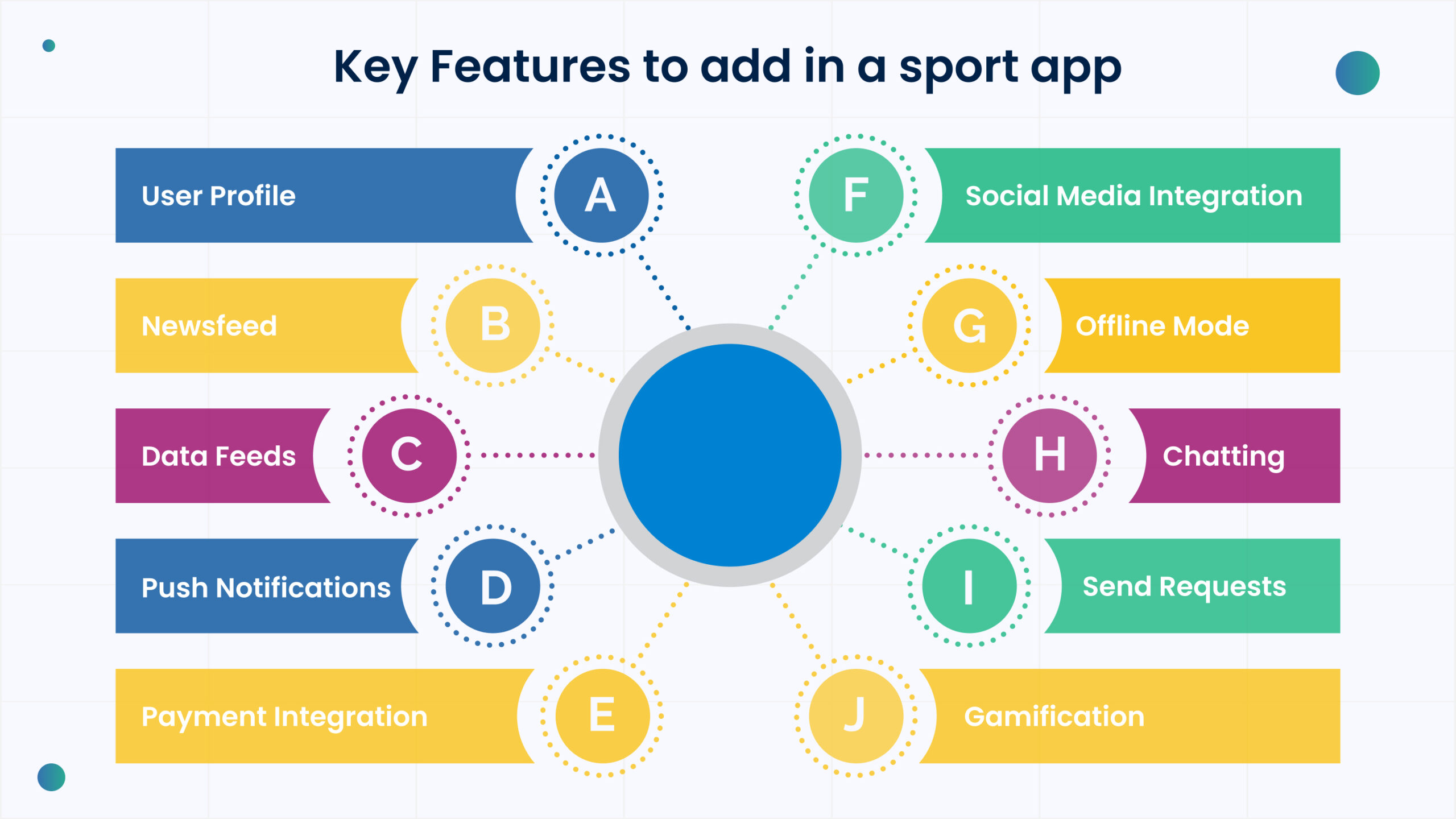
Sports App Development Ideas
The growing demand for sports apps has led many companies to enter this field. Creating a successful sports app requires creative ideas and careful planning. Here are some sports app concepts that can be a foundation for a user-friendly app tailored to your business needs:
1. Sports Coaching & Training App: This app can be a valuable tool for athletes. It can help them track their diet, schedule training sessions, monitor their sleep patterns, and even provide online coaching. Working with experts in custom mobile app development can make this idea a reality.
2. Fantasy Sports Applications:Fantasy sports apps let users act as team managers, creating dream teams of athletes and earning points based on real-game performance. This concept is very popular among sports fans, and hiring Android app developers can help you deliver a high-quality solution.
3. Live Streaming & Live Score Applications:With the rise of live streaming services, multiplatform live sports apps with interactive chat features have gained interest. This trend can be promising for those considering sports app development. Partnering with a reputable service provider can give you a competitive edge while staying within your budget.
4. Betting Apps: Combining favorite sports events with gambling can be exciting and potentially profitable. Adding features like internal currencies or cryptocurrency transactions can boost user engagement. Hiring skilled iPhone app developers with a proven track record is recommended for this project.
5. Sports League Management Apps: These apps are designed for coaches and athletes, offering tools for better team communication, performance tracking, and managing training sessions. Getting guidance from professionals can make your app unique and popular in this niche.
6. Sports Inventory & Equipment Store Apps: Similar to traditional e-commerce platforms, these apps cater to athletes and sports enthusiasts, offering a range of products like apparel, nutrition items, equipment, wearables, and merchandise. Collaborating with a dedicated development team is essential for ensuring your app’s success.
7. AR/VR Apps: Augmented Reality (AR) and Virtual Reality (VR) can set your sports app apart by providing immersive experiences. Users can feel like they’re part of the game, buy prime seats, or get valuable training insights from their homes. Working with Android app developers can help you bring this innovative concept to life.
8. Sports Event Booking Apps: These apps empower users to access venue maps, choose optimal seating using 3D stadium maps, and purchase event tickets. They also provide real-time event information and simplify food and beverage orders during events. Partnering with a mobile app development company can streamline the development process.
9. Sports News & Analysis Apps: These apps offer comprehensive sports coverage, including scores, news, interviews, products, and live streams. They are structured like traditional news sources, delivering a wealth of information with just a few clicks.
10. Sports Quiz App: A sports quiz app can generate revenue and provide a great return on investment. These games include captivating animations, audio commentary, and an immersive gaming experience that enhances sports knowledge and offers enticing rewards and prizes.
In summary, the demand for sports apps is on the rise. To create a successful app, you need creative ideas and thorough planning, along with collaboration with experienced app developers who can bring your vision to life.
Wrapping Up
To sum it up, the growing gaming industry offers a great chance to introduce a sports app, meeting the global demand for sports-related apps. Staying updated with changing trends and embracing innovative sports app ideas is crucial for creating a feature-packed application. Additionally, choosing experienced developers with a proven track record is essential for success in this dynamic field.
 19/09/2023
19/09/2023 
Anand Kumar Mishra
6 Mins to Read
Table of content
In 2023, the convergence of fitness and healthcare has given rise to a burgeoning demand for Fitness Healthcare Apps. These apps bridge the gap between maintaining a healthy lifestyle and managing personal healthcare. If you’re considering diving into the world of app development, building a Fitness Healthcare Mobile App could be a promising venture.
In this article, we’ll guide you through the steps, costs, and essential tech stack required to create a Fitness Healthcare App that caters to the evolving needs of users in 2023.
Steps to Create a Fitness Healthcare App
1. Define Your App’s Purpose and Features
Begin by outlining the core purpose of your Fitness App. Determine what specific fitness and healthcare aspects it will cover. Common features include:
– User Profiles: Allow users to create profiles with personal information, medical history, and fitness goals.
– Fitness Tracking: Incorporate features for tracking workouts, steps taken, calories burned, and distance covered.
– Health Monitoring: Implement tools for monitoring vital signs like heart rate, blood pressure, and sleep patterns.
– Health Records: Enable users to store and manage their medical records and history.
– Integration with Wearables: Consider integrating with popular fitness wearables like smartwatches and fitness bands.
– Consultation and Telemedicine: If possible, offer users the option to consult with healthcare professionals through video calls.
2. Choose a Development Approach
You have two primary options when it comes to app development:
– Native App Development: Develop separate apps for iOS and Android platforms. This approach provides better performance and access to platform-specific features.
– Cross-Platform Development: Use frameworks like React Native or Flutter to create a single codebase that works on both iOS and Android. This is cost-effective and quicker to deploy.
3. Design the User Interface (UI) and User Experience (UX)

Create an intuitive and user-friendly interface. Ensure that the design aligns with the healthcare theme while being visually appealing. Consider user journeys and how users will navigate through your app.
4. Backend Development
Develop the backend infrastructure for data storage, user authentication, and communication with external APIs. You may need to comply with healthcare data regulations, so ensure robust security measures are in place.
5. Integration with Health Data

To provide accurate fitness and healthcare data, integrate your app with APIs and databases that collect and process health information. Ensure that data is stored securely and in compliance with relevant privacy laws.
6. Build the Frontend
Develop the frontend of your app, focusing on making it responsive and compatible with various screen sizes and devices.
7. Test Thoroughly
Testing is critical for a Healthcare Mobile App. Test for usability, functionality, security, and compatibility. Consider conducting beta testing with real users to gather feedback.
8. Compliance with Regulations
Ensure that your app complies with healthcare and data privacy regulations, such as HIPAA in the United States or GDPR in Europe, depending on your target market.
9. Launch Your Fitness Healthcare App
Once you’ve thoroughly tested and ensured compliance, launch your app on the App Store and Google Play. Market it aggressively to reach your target audience.
10. Continuous Improvement
After the launch, continue to update and improve your app based on user feedback and emerging trends in fitness and healthcare.
Costs Involved in Creating a Fitness Healthcare Mobile App Development
The costs of developing a Fitness Mobile App can vary significantly based on several factors:
– Development Team: Salaries of developers, designers, and testers.
– Technology Stack: Costs associated with using specific programming languages, frameworks, and tools.
– Server Costs: Hosting and maintenance of backend servers.
– Compliance and Security: Expenses related to ensuring data security and regulatory compliance.
– Marketing and Promotion: Budget for marketing and promoting your app to attract users.
– Maintenance: Ongoing costs for updates, bug fixes, and improvements.
It’s essential to budget carefully and have a clear financial plan in place.
Tech Stack for Building a Fitness Healthcare App

The technology stack you choose can significantly impact your app’s performance, scalability, and development speed. Here’s a basic tech stack for a Fitness App:
– Programming Languages: Choose languages like JavaScript (for React Native), Dart (for Flutter), or Swift (for iOS) depending on your development approach.
– Frameworks: Consider using React Native or Flutter for cross-platform development, or Swift/Java/Kotlin for native development.
– Backend: Node.js, Python, Ruby on Rails, or Django can be good options for the backend.
– Database: PostgreSQL, MySQL, or MongoDB for data storage.
– Cloud Services: AWS, Google Cloud, or Azure for hosting and scaling.
– APIs: Integrate with health data APIs like Google Fit, Apple HealthKit, or third-party healthcare data providers.
– Security: Implement encryption, secure authentication, and compliance with healthcare data protection regulations.
– Analytics: Use tools like Google Analytics or Mixpanel to gather user insights.
Conclusion
In 2023, the demand for Fitness Healthcare Apps is on the rise as people become more health-conscious and tech-savvy. By following the steps outlined in this article and carefully considering your tech stack and budget, you can create a Fitness Healthcare App that not only meets user expectations but also contributes to the health and well-being of your users in the digital age. Building such an app requires dedication, but the potential benefits, both in terms of health impact and business success, make it a worthwhile endeavor in the modern world.
So, embark on your journey to create a Fitness Healthcare App, and help users achieve their fitness and healthcare goals with the power of technology.
 08/09/2023
08/09/2023 
Anand Kumar Mishra
9 Mins to Read
Table of content
In the ever-evolving landscape of mobile app development, one of the most crucial decisions that developers and businesses face is choosing the right approach for app development. Native and hybrid app development have long been at the forefront of this debate, with each approach having its own set of advantages and disadvantages. As we step into 2023, it’s essential to revisit this topic and examine the factors that can help you make an informed decision about which route to take.
Understanding Native App Development

Native app development involves creating applications that are specifically designed to run on a particular operating system, such as iOS or Android. These apps are coded using platform-specific languages and development tools. For instance, iOS apps are primarily built using Swift or Objective-C, while Android apps are developed using Java or Kotlin.
Advantages of Native App Development
1. Performance: Native apps are known for their superior performance. They can make the best use of the device’s hardware and are optimized for speed and responsiveness.
2. User Experience: Native apps provide a seamless and intuitive user experience. They are designed to look and feel like a natural extension of the device’s operating system.
3. Access to Device Features: Native apps have unrestricted access to all device features, including camera, GPS, and sensors, enabling developers to create feature-rich applications.
4. Offline Functionality: Native apps can work offline or in areas with limited connectivity, making them suitable for various use cases.
5. App Store Presence: Both Apple App Store and Google Play Store prioritize native apps, making it easier to discover and download them.
Disadvantages of Native App Development
1. Development Time: Developing separate apps for iOS and Android can be time-consuming and expensive, as you essentially need to build two separate codebases.
2. Cost: Native app development can be cost-prohibitive, especially for startups and small businesses, as it requires hiring platform-specific developers.
3. Maintenance: Maintaining two separate codebases for iOS and Android apps can be challenging, as updates and bug fixes need to be implemented separately.
Exploring Hybrid App Development

Hybrid app development seeks to bridge the gap between native and web applications. Hybrid apps are essentially web applications wrapped in a native shell, allowing them to be deployed across multiple platforms using a single codebase. Popular frameworks like React Native, Flutter, and Ionic have gained traction in the hybrid app development space.
Advantages of Hybrid App Development
1. Cross-Platform Compatibility: The primary advantage of hybrid apps is their ability to run on both iOS and Android platforms, saving time and resources.
2. Cost-Effective: Hybrid app development is more cost-effective compared to native app development, as it involves a single codebase and a shared development team.
3. Faster Development: Developing a hybrid app is generally faster than creating separate native apps for iOS and Android.
4. Easier Maintenance: Updates and bug fixes can be implemented once and deployed to both platforms, simplifying maintenance.
5. Web Technology: Hybrid apps leverage web technologies like HTML, CSS, and JavaScript, making it easier to find developers with web development skills.
Disadvantages of Hybrid App Development
1. Performance: Hybrid apps may not match the performance of native apps, as they rely on a web view component to render the user interface.
2. Limited Access to Device Features: While hybrid apps can access some device features, they may not have the same level of access and control as native apps.
3. User Experience: Achieving a native-like user experience can be challenging in hybrid app development, and it may require additional effort and customization.
Considering Cross-Platform Development

Cross-platform development is an approach that aims to combine the benefits of both native and hybrid development. It involves using a single codebase to create applications that can run on multiple platforms while maintaining a native-like user experience. Several frameworks and tools support cross-platform development, including Xamarin and Flutter.
Advantages of Cross-Platform Development
1. Single Codebase: Cross-platform development allows developers to write code once and deploy it across multiple platforms, reducing development time and costs.
2. Native-Like Performance: Modern cross-platform frameworks like Flutter are designed to deliver native-like performance and user experience.
3. Access to Native Features: Cross-platform development tools provide access to native device features, ensuring feature-rich applications.
4. Rapid Development: Cross-platform development accelerates the development process, enabling quicker time-to-market for your app.
5. Community and Support: Cross-platform frameworks have active communities and extensive documentation, making it easier for developers to find solutions to common problems.
Disadvantages of Cross-Platform Development
1. Learning Curve: Developers may need to learn new tools and frameworks when transitioning to cross-platform development.
2. Limited Control: While cross-platform tools provide access to native features, they may not support every niche or specialized functionality.
3. App Size: Cross-platform apps may have larger file sizes due to the inclusion of the framework itself.
Factors To Consider

Choosing the right approach for mobile app development in 2023 depends on various factors, including your project requirements, budget, timeline, and target audience. Here are some key considerations to help you make an informed decision:
1. Project Complexity
For simple and straightforward apps, hybrid or cross-platform development may be sufficient. However, if your project involves complex features or requires high-performance, native development is likely the better choice.
2. Development Speed
If you need to bring your app to market quickly, hybrid and cross-platform development offer faster development cycles due to their single codebase approach.
3. Budget
Consider your budget constraints. Native development can be more expensive due to the need for separate development teams, whereas hybrid and cross-platform development can be more cost-effective.
4. User Experience
If delivering a seamless and native-like user experience is a top priority, native development may be the way to go, as it offers the highest level of control over the user interface.
5. Target Audience
Understanding your target audience’s preferences can influence your choice. For instance, if you’re primarily targeting iOS users, starting with native development for iOS might make sense.
6. Long-Term Maintenance
Think about long-term maintenance and updates. If you anticipate frequent updates and feature additions, the efficiency of hybrid or cross-platform development may outweigh the initial advantages of native development.
7. Developer Skills
Assess your development team’s skills and expertise. If your team is already proficient in a specific technology or framework, it might be more efficient to leverage their existing knowledge.
8. Performance Requirements
Consider the performance demands of your app. If it requires extensive computational power or real-time processing, native development may be necessary to meet those requirements.
9. App Store Presence
If your app’s success relies on visibility and discoverability in app stores, native apps tend to have an advantage in this regard.
10. Future Plans
Think about your long-term goals. If you plan to expand to other platforms or devices in the future, a cross-platform approach may offer better scalability.
Conclusion
Ultimately, the best choice for app development in 2023 will depend on your specific circumstances and objectives. Carefully assess your project’s complexity, budget, timeline, and target audience to make an informed decision. Keep in mind that the mobile app development landscape is constantly evolving, with new tools and frameworks emerging regularly. Staying up-to-date with the latest developments in the field will also be crucial in making the right choice for your mobile app project.
In conclusion, whether you opt for native, hybrid, or cross-platform development, the success of your mobile app will largely depend on your ability to deliver a valuable and engaging user experience. Make your decision based on a thorough analysis of your project’s needs and consider seeking the expertise of experienced app developers who can guide you toward the most suitable path for your unique app development journey in 2023 and beyond.
 23/08/2023
23/08/2023 
Anand Kumar Mishra
7 Mins to Read
Table of content
In the fast-paced world of mobile app development, choosing the right technology stack is paramount to ensure the success of your app. With the evolution of frameworks and tools, developers are presented with a plethora of options. One technology that has consistently stood out is React Native.
In 2023, React Native continues to hold its ground as a preferred choice for mobile app development. This article delves into the reasons why React Native remains a compelling option for building mobile apps in this dynamic landscape.
What is React Native?
React Native is an open-source framework for building mobile applications. It was developed by Facebook and is widely used for creating cross-platform apps for iOS and Android platforms using a single codebase. The framework allows developers to write mobile apps using JavaScript and React, which is a popular JavaScript library for building user interfaces.
One of the key features of React Native is its ability to provide a native-like experience to users on both platforms. While traditional cross-platform frameworks often rely on web views to render app content, React Native uses native components to ensure better performance and a more authentic user experience.
With React Native, developers can build apps faster by reusing a significant portion of code between different platforms. This means that instead of creating separate codebases for iOS and Android, developers can write code once and deploy it on both platforms, saving time and effort.
The Rise and Resilience of React Native
In the dynamic world of mobile app development, few frameworks have sparked as much innovation and enthusiasm as React Native. Born from the brains at Facebook, React Native has redefined the way developers create mobile applications, offering a cross-platform solution that marries efficiency with native-like performance.
Its journey from inception to becoming a cornerstone in app development showcases both its rise and remarkable resilience.
What Makes React Native special?
Genesis and Innovation
React Native emerged as a revolutionary response to the challenges faced by developers who sought to create apps for both iOS and Android platforms. The idea of crafting a single codebase that could seamlessly translate into native experiences was a paradigm shift. Leveraging the principles of React, a JavaScript library used for web development, React Native brought the power of declarative components to the mobile realm.
The Cross-Platform Marvel

The primary allure of React Native lies in its cross-platform capability. Developers can write code once and deploy it across both iOS and Android devices, saving time, effort, and resources. Unlike traditional cross-platform solutions that often sacrifice performance for universality, React Native maintains the fluidity and responsiveness users expect from native apps.
Fusion of Performance and Flexibility
The secret behind React Native’s native-like performance lies in its utilization of native components. Rather than relying solely on web views, it employs actual native UI components, enabling smooth interactions and faster rendering. This fusion of performance and flexibility has not only impressed developers but also elevated user satisfaction.
The “Hot Reload” Advantage
React Native introduces a game-changing feature known as “hot reload.” This feature enables developers to witness real-time changes in the code without restarting the app. The immediate feedback loop accelerates development, streamlines debugging, and encourages experimentation.
Community Empowerment
React Native’s growth can be largely attributed to its robust and active community. From developing new libraries to addressing issues, this collaborative environment has nurtured the framework’s evolution. Countless open-source contributions and a wealth of resources, from documentation to tutorials, have made React Native accessible and adaptable.
Challenges and Resilience
No journey is without its challenges. React Native faced criticisms about its performance on more complex applications, but the community and core developers actively addressed these concerns. Continuous updates, optimizations, and the introduction of features like “TurboModules” have further fortified React Native’s resilience.
The Ongoing Story
As we stride into the future, React Native continues to evolve. Its adoption has been significant not only among startups looking to make a splash but also for established companies aiming to streamline their app development processes. From global giants to indie developers, React Native has cemented its status as a versatile and powerful solution.
Benefits of Using React Native for Mobile App Development

The ability to refine searches based on cuisine type, dietary preferences, or location is a must-have feature. Zomato’s search filters allow users to narrow down their choices, making it convenient to find exactly what they’re craving, whether it’s a vegan-friendly option or a specific type of cuisine.
1. Cross-Platform Compatibility
Time-to-market is a critical factor in the success of any app. React Native expedites the development process through its “hot reloading” feature, which allows developers to instantly view the changes they make without recompiling the entire app. This iterative approach accelerates debugging and iteration, leading to quicker updates and releases.
2. Faster Development Cycle
In the contemporary mobile app ecosystem, catering to both iOS and Android users is essential for reaching a wider audience. React Native excels in this aspect by enabling developers to write a single codebase that works seamlessly on both platforms. This eliminates the need for developing separate apps from scratch, saving time and effort.
3. Reusable Components
React Native’s component-based architecture encourages the creation of reusable UI components. These components can be integrated into different parts of the app, ensuring a consistent design language and user experience. This modularity not only streamlines development but also enhances code maintainability.
4. Third-Party Plugins and Libraries
The React Native ecosystem boasts an extensive collection of third-party plugins and libraries. These pre-built solutions address various functionalities, from authentication to analytics, reducing the need to build everything from scratch. In 2023, the availability of these resources continues to be a significant advantage, enabling developers to focus on core app features.
5. Performance and Native Experience
One common concern with cross-platform frameworks is performance. React Native tackles this issue by enabling the integration of native modules and components. This ensures that the app delivers a smooth and responsive user experience, akin to that of a fully native app. The performance enhancements introduced in recent years have solidified React Native’s position as a high-performing framework.
6. Strong Community Support
The React Native community has played a pivotal role in its success. Developers worldwide actively contribute to the framework’s growth by sharing best practices, troubleshooting issues, and developing new tools. This collaborative atmosphere ensures that React Native stays up-to-date with the latest industry trends and innovations.
7. Cost-Effectiveness
In a business landscape driven by efficiency and cost-effectiveness, React Native shines as a cost-efficient solution. The ability to write a single codebase for multiple platforms significantly reduces development expenses. This is particularly beneficial for startups and small businesses that aim to deliver feature-rich apps without stretching their budgets.
8. Maintenance and Updates
As mobile devices and operating systems evolve, app maintenance becomes a critical concern. React Native simplifies this aspect by facilitating updates across platforms through a single codebase. This means that when new OS versions or devices emerge, developers can make necessary adjustments without overhauling the entire app architecture.
Closing Statement
In 2023, React Native stands tall as a reliable and efficient choice for mobile app development. Its cross-platform capabilities, rapid development cycle, and robust community support make it a formidable contender in the ever-changing landscape of technology. As businesses strive to create innovative and user-friendly apps, React Native offers a pathway to success by combining the best of both worlds: code efficiency and exceptional user experiences. Embracing React Native is not just a technological decision; it’s a strategic move towards delivering impactful mobile applications to a global audience.


 Mobile Apps
Mobile Apps Web Apps
Web Apps Blockchain
Blockchain Digital Marketing
Digital Marketing Others
Others